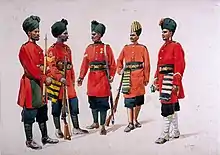Nizam's Contingent
The Nizam's Contingent, later Hyderabad Contingent, was a British-officered army of the Nizam of Hyderabad.[1]
| Nizam's Contingent | |
|---|---|
| Active | 1798 - 27 October 1945 |
| Allegiance | Company rule in India (1853-1858) |
| Branch | |
| Type | Cavalry |
| Size | Regiment |

History
The Nizam's Contingent was formed through the plan of Governor-General Richard Wellesley, 1st Marquess Wellesley to rid British India of French influence. On arriving in India in 1798, he effected the disbandment of the Nizam of Hyderabad's Indian units that had been under the command of the Frenchman Monsieur Raymond and officered by non-British Europeans.
The disbanded units would be formed into a British-officered army and would fight with the East India Company troops during the Mysore campaign (1790 - 1792) and their efforts at the Siege of Seringapatam against Tipu Sultan in the final battle of the Fourth Anglo-Mysore War would earn approbation of the Arthur Wellesley, 1st Duke of Wellington, who recorded that they 'behaved well.'[2]
The Madras Presidency would have no cause to raise Irregular troops as the services of the Nizam's forces could be relied upon for support.[3]
Russell Brigade
In 1813, Sir Henry Russell, 2nd Baronet, the British Resident to the court of the Nizam of Hyderabad, raised the Russell Brigade, comprising two battalions. Later, four more battalions were raised and they were known as the Berar Infantry. In addition, two battalions, known as the Elichpur Brigade, were raised by Nawab Salabat Khan, Subedar of Berar, but formed part of the Nizam's forces. The men of the Russell Brigade were chiefly Hindus, recruited from Oudh and other parts of Uttar Pradesh.[4]
Hyderabad Contingent
By 1853, at the time of the signing of a treaty between the Nizam and the British, the Nizam's forces consisted of eight battalions. The East India Company assumed the responsibility for maintaining the Nizam's Contingent, renaming it the Hyderabad Contingent in exchange for rights to administer the Berar Division. The Hyderabad Contingent would serve closely alongside the Madras Army of the East India Company.
Indian Rebellion of 1857
The Hyderabad Contingent would remain loyal to Company rule in India during the Indian Rebellion of 1857, effectively stemming the revolt in the Carnatic and Mysore regions.
British Raj
During the British Raj, the unit would see serve in Burma (1885-1887), on the North-West Frontier (1897) and in the Boxer Rebellion (1900). In 1902, seven regiments would be transferred to the British Indian Army.
World War I
On 23 October 1917, during the World War I, a Kumaon Battalion was raised at Ranikhet as the "4/39th Kumaon Rifles". In 1918, this unit was redesignated as the 1st battalion, 50th Kumaon Rifles, and a second battalion was raised. These were merged with the Hyderabad Contingent into the 19th Hyderabad Regiment in 1922. Some units of the regiment were demobilized after the war, but the regiment would be again expanded during the World War II.
Kumaon Regiment
As links with Hyderabad and Deccan lessened, calls to rename the regiment were heard. On 27 October 1945, the 19th Hyderabad Regiment was renamed the 19th Kumaon Regiment and renamed again as the Kumaon Regiment after the independence of India.
References
- http://www.indianarmy.gov.in/Site/FormTemplete/frmTemp12PLM8C.aspx?MnId=l7m6i4kBQ6GVWWXGRMx4Yg==&ParentID=RSkliQ1ACw1V89B4Pg1idw==
- "Centrepiece of First or Royal Colour, 8th Regiment of Infantry, Nizam's Army, 1850". collection.nam.ac.uk. National Army Museum. 2 June 2023. Retrieved 2 June 2023.
- "Centrepiece of First or Royal Colour, 8th Regiment of Infantry, Nizam's Army, 1850". collection.nam.ac.uk. National Army Museum. 2 June 2023. Retrieved 2 June 2023.
- "The Official Home Page of the Indian Army".